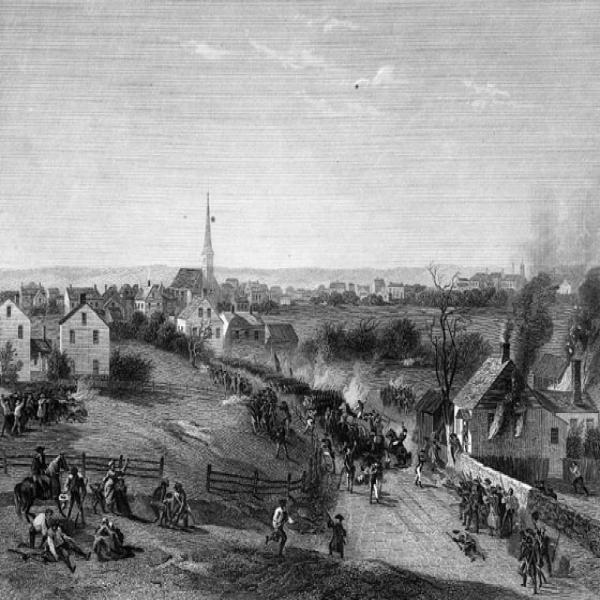Retreat of the British from Concord
Original

Background Notes
Retreat of the British from Concord is an engraving by James Smilie (1807-1885), who was born in Scotland, lived in Quebec, and eventually moved to New York City. He worked mostly on banknote engravings, but was also known for his landscapes. The engraving is based on a painting by Alonzo Chappel, and portrays the aftermath of the fighting and destruction within Concord while the British retreat down the road that leads back to Lexington.
April 19, 1775 was the first day of the American Revolution. There were several events that led up to this fateful day, including the Boston Massacre, Boston Tea Party, and the Stamp Act, to name a few. The colonists were agitated by the policies that the British crown continued to place on them, and decided to prepare their defense. A group of colonists in Massachusetts created the Massachusetts Provincial Congress, and began to store large quantities of guns and ammunition. The British found out about this, and sent Lt. Col. Francis Smith and his men to dismantle and destroy the weapons. The colonists in Concord and Lexington were warned of the impending arrival of the British, so, under the leadership of Capt. John Parker (1729-75) they had time to arm themselves and to meet up with the British in Lexington around dawn. As the British were telling the militia to back down, someone fired a shot. No one knows who fired this first shot, or if it was intentional or accidental, but it set off a round of firing from both sides. After the firing ceased, seven militiamen were dead and nine were wounded. Smith and his troops soon departed and continued on their way to Concord. In the meantime, warning already had been sent that the British were still intending to head to Concord to complete their mission. This gave the militia in Concord time to regroup and set out to meet the British. The British entered Concord to search for weapons, which they then dumped in the pond or burned. The militiamen could see the destruction from their posts near the North and South Bridges, and feared that the British were going to burn the entire town. The militia then closed in on the British troops at the North Bridge. Shots were fired again, and the British scattered back into Concord. A few hours later, Smith organized his troops to retreat from Concord. However, they again met with resistance from the militia outside of town. They continued to battle all day, fighting all the way back to Charlestown. By the end of the day, a few hundred men lay dead or wounded.
Groce, George C. and David H. Wallace, The New York Historical Society's Dictionary of Artists in America, 1564-1860, New Haven: Yale University Press, 1957. pg. 120.
Groce, pg. 585
Nebenzahl, Kenneth, Atlas of the American Revolution, New York: Rand McNally & Co., 1974. pg. 39. And Morris, Richard B. Encyclopedia of American History, New York: Harper & Bros., 1953. pg. 85-86.
Groce, George C. and David H. Wallace, The New York Historical Society's Dictionary of Artists in America, 1564-1860, New Haven: Yale University Press, 1957. pg. 120.
Groce, pg. 585
Nebenzahl, Kenneth, Atlas of the American Revolution, New York: Rand McNally & Co., 1974. pg. 39. And Morris, Richard B. Encyclopedia of American History, New York: Harper & Bros., 1953. pg. 85-86.
Http://www.patriotresource.com/battles/lexington/page7.html